日本文化风俗超详细英文版
日本文化介绍英文版
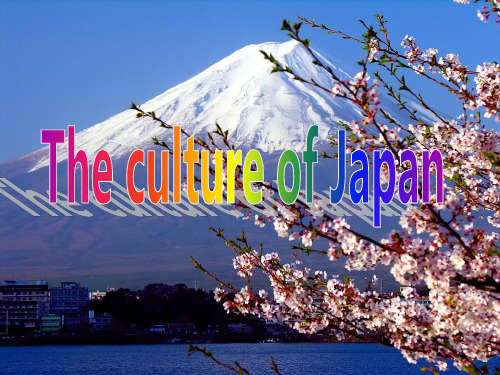
Cherry blossom is an omen of good fort une and is also an emblem of love, affect ion and represents spring. Cherry blosso ms• are an enduring metaphor for the fle eting nature of life, and as such are freq uently depicted in art.
• The folk dances and traditional art can’t do wi thout kimono, for the kimono can display the e legancy and beauty of Japanese women. Japan ese people always wear business suit when the y work, especially for people work outside and salesman, their companies demand the worker must wear business suit.
attracts mang tourists.
Flower Viewing
"Hanami"is the Japanese traditional custom of enjoying the beauty of flowers, "flower" in this case almost always meaning cherry blossoms or ume blossoms. From the end of March to early May, sakura bloom all over Japan.
描述日本风俗文化英语作文

Title: Embracing the Unique Customs andCulture of JapanJapan, an island nation steeped in history and tradition, presents a fascinating tapestry of customs and culture. From the elegant precision of its tea ceremony to the vibrant energy of its festivals, Japan offers a rich palette of experiences that are both enchanting and enlightening.The heart of Japanese culture lies in its respect for tradition and reverence for nature. This is reflected in the meticulous attention to detail in all aspects of daily life, whether it's the meticulous care taken in preparing a meal or the precision with which tea is poured during the tea ceremony. The tea ceremony, known as "sado," is notjust about drinking tea; it's an elaborate ritual that involves the harmonious interaction of host and guest, the appreciation of the beauty of nature, and the pursuit of inner peace.Another hallmark of Japanese culture is its emphasis on community and collective harmony. This is evident in the way Japanese people greet each other with bows and politephrases, demonstrating respect and consideration for others. The concept of "wa," which translates to harmony or unity,is ingrained in Japanese society and is reflected invarious aspects of life, from social interactions to theway businesses are conducted.Festivals and celebrations are an integral part of Japanese culture, with each season marked by special events and traditions. The cherry blossom viewing, known as "sakura-viewing," is a national obsession, with people flocking to parks and temples to admire the delicate beauty of the flowers. The autumn moon viewing, on the other hand, is a time for family reunions and the appreciation of thefull moon against the backdrop of autumn foliage.The visual arts of Japan are also a testament to itsrich cultural heritage. From the delicate brushstrokes of traditional Japanese painting to the intricate carvings of lacquerware, Japanese artists have perfected the art of combining beauty and functionality. The art of origami, the folding of paper into intricate shapes, is another exampleof Japanese creativity and craftsmanship.In conclusion, Japan's customs and culture are atapestry of tradition, harmony, and natural beauty. Fromthe precision of its tea ceremony to the vibrantcelebrations of its festivals, Japan offers a unique and enchanting experience that leaves a lasting impression on those who visit. Embracing these customs and traditions,one can truly appreciate the depth and richness of Japanese culture.**拥抱日本独特的风俗文化**日本,这个岛屿国家拥有丰富的历史和传统,展现了一幅迷人且多姿多彩的风俗文化画卷。
日本婚俗文化 (中英文)

The three cups from down to up in turn put mule, groom picked up the first cup, sip three wine, and then to the bride, the bride also sip three consecutive wine, then wine glasses in turn passed on to other friends and relatives.
新娘离开娘家大门时,要将她的足迹扫掉,或者在门 口摔碎一个茶碗,希望新娘到新郎家之后生活美满, 永不返回娘家。
Because the family is not harmonious in Japan ran back to her maiden is a 在日本因为家庭不和睦跑回自己的娘家是很丢人的事。 shameful thing.
After the groom on their doorstep for the bride, two people to worship of water, vulcan, and kitchen
新郎在自己家门口迎来新娘后, 两人要拜水神、火神和灶神
Before Buddha ceremony 佛前式
比如,鱼头和鱼尾都被向上卷起,整条鱼围成一 个圆圈,象征夫妻永不分离。
龙虾在婚宴上也很常见,因为龙虾的深红色代表好运气。
Lobster at the wedding banquet is also very common, because of the deep red represents good luck.
在举行婚礼时,神职人员祈求神灵保佑新婚夫妻。
日本婚俗文化 (中英文)

Friends and family a toast toast each other.
亲友举杯互敬
Front of type人前式
主要是在城市,人前结婚式就是在宾馆、饭店举行的结 婚仪式。 Is primarily in cities, people
新娘的头发应该挽起来,用龟壳梳子束住,还要戴 上一顶称为“角瘾”的帽子盖住发,有“盖住棱角” 之意,
The marriage should be convergence his temper, do a good wife and a devoted mother.
婚后应该收敛脾气,做一个 贤妻良母。
一套茶具和一包糖果点心。
Family ceremony
家庭式
In this way is mainly rural places.
主要是乡村地方采用这种方式。
The bride home doors, will sweep off her footprint, or break a bowl in the doorway, hope after the bride to the groom's family happy happy life, never to return home.
At the wedding, a bride will change several sets of cloቤተ መጻሕፍቲ ባይዱhes.
在婚礼上,新娘子还要换好几套衣服。
Is an off white dress, wearing embroidered with auspicious patterns (like cranes, flowers, etc.), gorgeous dress, color is gold, silver, red three 一次是脱掉白色礼服,换上绣有吉祥图案(像仙鹤, color.
日本的风俗习惯英语作文
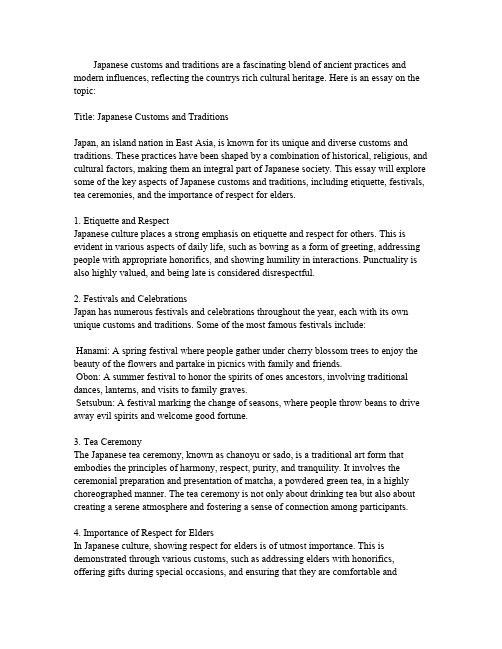
Japanese customs and traditions are a fascinating blend of ancient practices and modern influences,reflecting the countrys rich cultural heritage.Here is an essay on the topic:Title:Japanese Customs and TraditionsJapan,an island nation in East Asia,is known for its unique and diverse customs and traditions.These practices have been shaped by a combination of historical,religious,and cultural factors,making them an integral part of Japanese society.This essay will explore some of the key aspects of Japanese customs and traditions,including etiquette,festivals, tea ceremonies,and the importance of respect for elders.1.Etiquette and RespectJapanese culture places a strong emphasis on etiquette and respect for others.This is evident in various aspects of daily life,such as bowing as a form of greeting,addressing people with appropriate honorifics,and showing humility in interactions.Punctuality is also highly valued,and being late is considered disrespectful.2.Festivals and CelebrationsJapan has numerous festivals and celebrations throughout the year,each with its own unique customs and traditions.Some of the most famous festivals include:Hanami:A spring festival where people gather under cherry blossom trees to enjoy the beauty of the flowers and partake in picnics with family and friends.Obon:A summer festival to honor the spirits of ones ancestors,involving traditional dances,lanterns,and visits to family graves.Setsubun:A festival marking the change of seasons,where people throw beans to drive away evil spirits and welcome good fortune.3.Tea CeremonyThe Japanese tea ceremony,known as chanoyu or sado,is a traditional art form that embodies the principles of harmony,respect,purity,and tranquility.It involves the ceremonial preparation and presentation of matcha,a powdered green tea,in a highly choreographed manner.The tea ceremony is not only about drinking tea but also about creating a serene atmosphere and fostering a sense of connection among participants. 4.Importance of Respect for EldersIn Japanese culture,showing respect for elders is of utmost importance.This is demonstrated through various customs,such as addressing elders with honorifics, offering gifts during special occasions,and ensuring that they are comfortable andwellcared for.This respect extends to teachers,bosses,and other authority figures as well.5.Traditional Arts and CraftsJapan has a rich tradition of arts and crafts,which are considered an essential part of its cultural heritage.Some of the most notable examples include:Ikebana:The art of flower arrangement,which emphasizes the beauty of nature and the balance of colors and shapes.Origami:The art of paper folding,creating intricate designs and shapes from a single sheet of paper.Pottery and ceramics:Japan is famous for its highquality pottery,such as Arita ware and Kutani ware,which are known for their intricate designs and vibrant colors.6.Traditional ClothingTraditional Japanese clothing,such as the kimono and yukata,are still worn on special occasions and festivals.The kimono is a long,Tshaped robe with intricate patterns and designs,while the yukata is a lighter,casual garment typically worn during summer events.7.Food CultureJapanese cuisine is known for its emphasis on fresh ingredients,delicate flavors,and beautiful presentation.Traditional meals often consist of a variety of dishes,including rice,fish,vegetables,and soup.Eating with chopsticks is the norm,and there are specific customs associated with their use,such as not sticking them vertically into a bowl of rice, as this is considered disrespectful.In conclusion,Japanese customs and traditions are a reflection of the countrys deeprooted cultural values and beliefs.From etiquette and respect to festivals and the arts,these practices play a vital role in shaping the identity and way of life of the Japanese people. Understanding and appreciating these customs can provide a deeper insight into the rich tapestry of Japanese culture.。
英文版日本文化介绍 Japanese culture

creamy sauces and strong smelling foods
Food & Drink in China
Chinese habits:
•always a cup, a bowl on a small dish, together with the chopsticks and table spoons •cooked food •whole plate of dishes for everyone •accompanied by tea, beer or distilled spirit •required to keep silent
Long term orientation
•See their life as a very short moment in a long history of mankind
•Live their lives guided by virtues and practical good examples
avoid
in obtrusive way complain directly
Business Etiquette in Japan
Rachel
Appointments Appearance Meet & Greet Business cards Business seating order Business dealings Decisions & Contracts Giving gifts
Business Customs in Japan
ONE
Overall Situation of Japan
TWO
习俗礼仪中英文对照
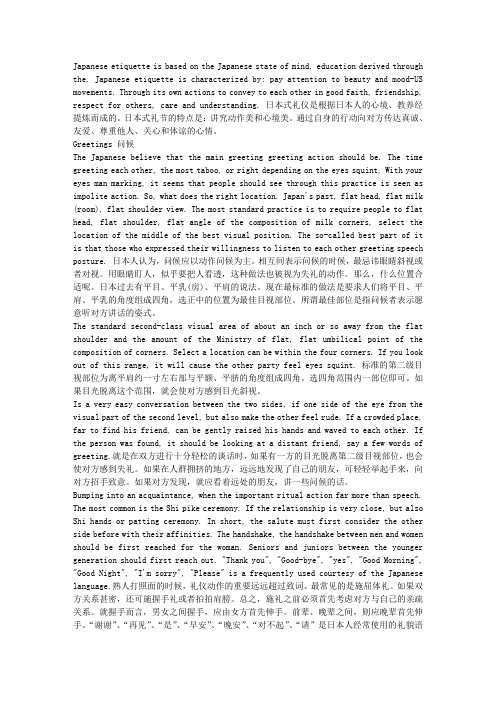
Japanese etiquette is based on the Japanese state of mind, education derived through the. Japanese etiquette is characterized by: pay attention to beauty and mood-US movements. Through its own actions to convey to each other in good faith, friendship, respect for others, care and understanding. 日本式礼仪是根据日本人的心境、教养经提炼而成的。
日本式礼节的特点是:讲究动作美和心境美。
通过自身的行动向对方传达真诚、友爱、尊重他人、关心和体谅的心情。
Greetings 问候The Japanese believe that the main greeting greeting action should be. The time greeting each other, the most taboo, or right depending on the eyes squint. With your eyes man marking, it seems that people should see through this practice is seen as impolite action. So, what does the right location. Japan's past, flat head, flat milk (room), flat shoulder view. The most standard practice is to require people to flat head, flat shoulder, flat angle of the composition of milk corners, select the location of the middle of the best visual position. The so-called best part of it is that those who expressed their willingness to listen to each other greeting speech posture. 日本人认为,问候应以动作问候为主。
优选日本文化介绍英文版

In modernday Japan, hanami mostly consists of having an outdoor party beneath the sakura during daytime or at night. Hanami at night is called yozakura . In many places such as Ueno Park temporary paper lanterns are hung for the purpose of yozakura.
优选日本文化介绍英文版
Cherry Blossom
Cherry Blossoms is a national flower of Japen.In the middle of every march to mid April ,is Japen from the south to the north of
The blossom fቤተ መጻሕፍቲ ባይዱrecast , sakurazensen, literally cherry blossom front is announced each year by the weather bureau, and is watched carefully by those planning hanami as the blossoms only last a week or two.
Cherry blossom is an omen of good fort une and is also an emblem of love, affect ion and represents spring. Cherry blosso ms• are an enduring metaphor for the fle eting nature of life, and as such are freq uently depicted in art.
日本文化介绍(全英文版)
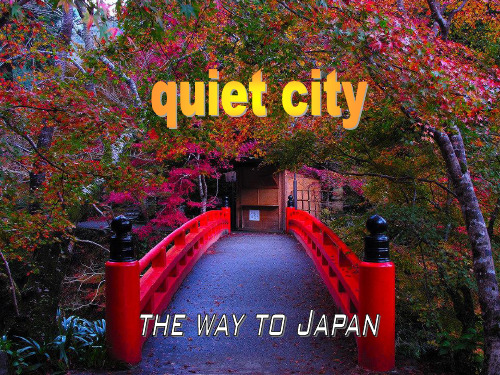
Composition
• The main islands, sometimes called the "Home Islands", are (from north to south) Hokkaidō, Honshū (the "mainland"), Shikoku and Kyūshū. There are also about 3,000 smaller islands, including Okinawa, and islets, some inhabited and others uninhabited. In total, as of 2006, Japan's territory is 377,923.1 km² , of which 374,834 km²is land and 3,091 km²water. This makes Japan's total area slightly smaller than the U.S. state of Montana, slightly bigger than the Brazilian state of Mato Grosso do Sul. Japan is bigger than Germany, Malaysia, New Zealand and the U.K., and is 1.7 times the (和服)
The kimono is a Japanese traditional garment worn by women, men and children. The word "kimono", which literally means a "thing to wear" (ki "wear" and mono "thing"), has come to denote these full-length robes. The standard plural of the word kimono in English is kimonos,[but the unmarked Japanese plural kimono is also sometimes used. Kimono are T-shaped, straight-lined robes worn so that the hem falls to the ankle, with attached collars and long, wide sleeves. Kimono are wrapped around the body, always with the left side over the right (except when dressing the dead for burial),[and secured by a sash called an obi, which is tied at the back. Kimono are generally worn with traditional footwear and split-toe socksToday, kimono are most often worn by women, and on special occasions. Traditionally, unmarried women wore a style of kimono called furisodewith almost floor-length sleeves, on special occasions. A few older women and even fewer men still wear the kimono on a daily basis. Men wear the kimono most often at weddings, tea ceremonies, and other very special or very formal occasions. Professional sumo wrestlers are often seen in the kimono because they are required to wear traditional Japanese dress whenever appearing in public
日本文化风俗超详细(英文版)

become adults.
furisode
zōri sandals
Kimono a piece of cloth
Furisode 振袖和服
Ocassion Ceremony of coming of age Graduation ceremony Banquet Visiting
A full set of formal clothing is expensive, so it is usually either borrowed from a relative or rented rather than bought especially for the occasion.
Japanese bushido 武士道精神
temporary aesthetics .极致美学
Cherry blossoms are beautiful ,they devote their all life to the nature and spring . And so can you do for yourself.
New Year
Preperation:December 13th ~30th New year's eve:December 31th New Year :January 1st ~3rd
round rice cake
镜 饼
New Year's Eve
New Year's Eve
年 賀 状
March 14th~April 15th
The National Flower
In spring , cherry blossoms appear almosteverywhere in Japan. They add up a lot of beauty for this season.
日本文化风俗超详细(英文版)
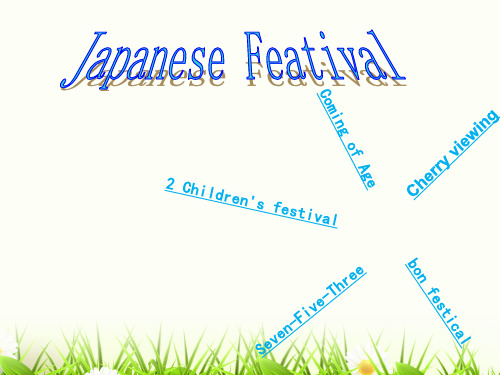
Girl's Day(Doll‘s Day) March 3rd
Boy's Day May 5th
like a carp leaping into the Dragon's Gate
calamus leaf cake rice cake
1 1 1 1 1 1 1
Crane&turtel longevity Red &white lolipops good luck
Japanese bushido 武士道精神
temporary aesthetics .极致美学
Cherry blossoms are beautiful ,they devote their all life to the nature and spring . And so can you do for yourself.
At last ,I wish that every one can try his or her best to arrive the top of your life .
End
A full set of formal clothing is expensive, so it is usually either borrowed from a relative or rented rather than bought especially for the occasion.
New Year's Eve
年 賀 状
Fortune Bags
。
福袋(ふくぶく ろ)
Significance:
It is held in order to
conห้องสมุดไป่ตู้ratulate and
Japan日本习俗英文介绍

APPELLATION Before the end of the 19th century, kimono occasionally was also called wu clothing. After the Meiji restoration, the appellation of kimono started to be fixed used,which was the concept that rose in the contact with the western culture. The wu Appellation dated back to the Three Kingdoms period in China.
The kinds of kimono
• Many different kinds of kimono, not only has the branch of men's and women's kimono, unmarried, married, and have a casual and dress.Men's kimono design is less, the color is dull, dark, thin belt, wear also convenient.Women's kimono style variety, colour is gorgeous, belt width,
Kimono in different periods in the history of Japanese
Nara Period
Heian
Period
Kamakura Period
Muromachi Period
Azuchi--Momoyama Period
日本文化介绍全英文版 ppt课件

• The population ranking of Japan dropped from 7th to 8th in 1990 and from 8th to 9th in 1998 and 10th since
Japan
•
Japan is an
island nation in
East Asia
comprising a
large
ห้องสมุดไป่ตู้
stratovolcanic
archipelago extending
along the Pacific coast
of Asia. Measured from the geographic coordinate system, Japan is 36° north of the equator and 138° east of the Prime Meridian. The country is north-northeast of China and Taiwan (separated by the East China Sea) and slightly east of Korea (separated by the Sea of Japan). The country is south of the Russian Far East.
Climate
• Japan belongs to the temperate zone with four distinct seasons, but its climate varies from cool temperate in the north to subtropical in the south. The climate is also affected by the seasonal winds that blow from the continent to the ocean in winters and vice versa in summers. Japan is generally a rainy country with high humidity. Because of its wide range of latitude, Japan has a variety of climates, with a range often compared to that of the east coast of North America, from Nova Scotia to Georgia. Tokyo is at about 35 degrees north latitude, comparable to that of Tehran, Athens, or Las Vegas. The generally humid, temperate climate exhibits marked seasonal variation celebrated in art and literature, as well as regional variations ranging from cool in Hokkaidō to subtropical in Kyūshū. Climate also varies with altitude and with location on the Pacific Ocean or on the Sea of Japan. Northern Japan has warm summers but long, cold winters with heavy snow. Central Japan has hot, humid summers and short winters, and southwestern Japan has long, hot, humid summers and mild winters.
- 1、下载文档前请自行甄别文档内容的完整性,平台不提供额外的编辑、内容补充、找答案等附加服务。
- 2、"仅部分预览"的文档,不可在线预览部分如存在完整性等问题,可反馈申请退款(可完整预览的文档不适用该条件!)。
- 3、如文档侵犯您的权益,请联系客服反馈,我们会尽快为您处理(人工客服工作时间:9:00-18:30)。
Japan - Obon
(日本-盂兰盆节)
Obon Festival
August 13–16
Honor the spirits of ancestors Family gathering
Filial piety
Obon dance
Cherry Blossom Festivals
Hanami 花見
New Year
Preperation:December 13th ~30th New year's eve:December 31th New Year :January 1st ~3rd
round rice cake
镜 饼
New Year's Eve
New Year's Eve
年 賀 状
Girl's Day(Doll‘s Day) March 3rd
Boy's Day May 5th
like a carp leaping into the Dragon's Gate
calamus leaf cake rice cake
1 1 1 1 1 1 1
Crane&turtel longevity Red &white lolipops good luck
become adults.
furisode
zōri sandals
Kimono a piece of cloth
Furisode 振袖和服
Ocassion Ceremony of coming of age Graduation ceremony Banquet Visiting
A full set of formal clothing is expensive, so it is usually either borrowed from a relative or rented rather than bought especially for the occasion.
At last ,I wish that every one can try his or her best to arrive the top of your life .
End
Japanese bushido 武士道精神
temporary aesthetics .极致美学
Cherry blossoms are beautiful ,they devote their all life to the nature and spring . And so can you do for yourself.
March 14th~April 15th
The National Flower
In spring , cherry blossoms appear almosteverywhere in Japan. They add up a lot of beauty for this season.
Extreme beauty and quick death.
Fortune Bags
。
福袋(ふくぶくろ)
Significance:
It is held in order to
congratulate and
encourage all those wyears
old ,and to help them
realize that they have
